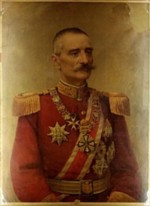Ljubljana
Since 1992, when the Socialist Federal Republic of Yugoslavia fell apart, Ljubljana has been the capital of the independent State of Slovenia. Prior to the creation of Yugoslavia, in 1918, Slovenia was part of the Austro-Hungarian (Habsburg) Empire that met its demise with its defeat in World War 1. This heritage is still evident in the architecture.
Economically, Slovenia is now one of the best performing remnants of the former Yugoslavia. It's been part of the Euro Zone since 2007 and has an unemployment rate close to the European Union average.
As we had the car, we booked in at a B&B that's really a motel, with breakfast included, and a convenient adjacent supermarket. Although there was public transport, it turned out to be more convenient to drive in to a park on the edge of the city, with a free car-park, and to walk in. This gave us an opportunity both to: get lost in the one-way system, while driving; and to see quite a bit of the city that's not on the usual tourist agenda, while walking.
Ljubljana pedestrian zone and the Ljubljana River
Another day another castle - Ljubljana Castle that stands above the city is reached by a funicular railway - you know 'feniculi-funicular' - about the seductive potential of these newfangled inclinators:
|
|
| No responsibility is accepted for linked third party video or media content - see Terms of Use and Copyright. You follow any YouTube links or advertisements displayed at your own risk. |
Ljubljana Castle
It has a great double-helix stair system to the tower - one helix up and the other down. But no sitting on the walls even though it's a shorter fall than at Bled.
In the Castle there's a museum that actually harks back to Yugoslavia
In most other museums this period is a blank
This is a bust of Tito and an example - there were several including small arms - of a manufactured item
Josip Broz Tito - otherwise known as President Tito of Yugoslavia - led the Yugoslav (Communist) Partisans during WW2 against the Axis Powers and then post-war Yugoslavia. This is the only image of him we've seen on this trip.
In his time Yugoslavia apparently manufactured cool motorbikes and smallarms, among other things on display here. Once he died it all began to fall apart. By 1992 the Balkans were balkanised once more. Did anyone say BREXIT?
Of course, Tito never knew. He died confident that Yugoslavia would continue as a united commonwealth into the distant future.
The National Gallery of Slovenia (Narodna Galerija) was also worth a visit.
The National Gallery of Slovenia (Narodna Galerija)
At the bottom is a 'Crystal Reliquary of St John the Baptist's Blood'
Among the Gallery's collection is a 'Crystal Reliquary of St John the Baptist's Blood' from the early 13th century. Presumably Salome saved a pint or two for posterity.
The wide scale practice of manufacturing reliquaries, to attract pilgrims, was one of the things that so incensed the Protestants in the 16th century. After the Reformation, the Roman Church largely abandoned the practice but there are many we've seen that are still actively revered. Many are beautifully crafted in precious metals and jewels and often contain body parts. The gallery has some particularly beautiful examples. They now attract tourists.

